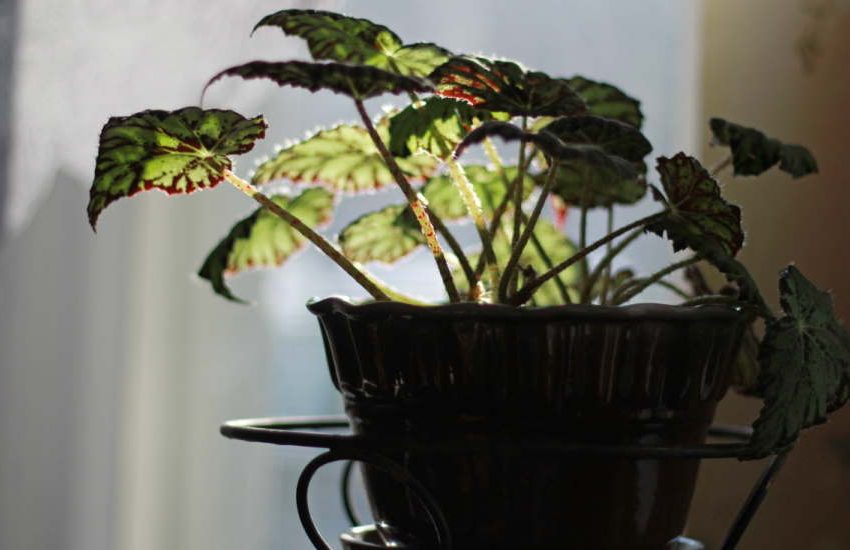14 Flowering Vines To Grow In Maryland
1. Purple Passionflower (Passiflora Incarnata)
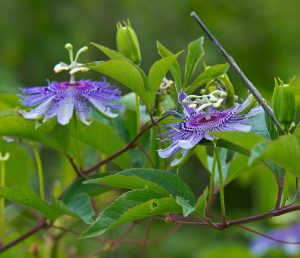
Passionflower is an enduring vine even in the winter months. A recommendation for winter maintenance is to keep watering it regularly throughout the cold season in Maryland. It’s best to plant it in a dark dry place. Purple Passionflower sheds its leaves in the winter months making way for a beautiful bloom beginning in July. The pretty passionflowers last until October.
Purple Passionflower is also commonly called True Passionflower, Maypop, Wild Apricot, and Wild Passion Vine. Its stems are smooth, and they grow appealing long and trailing. The lobed leaves are palmately three-lobed and sometimes up to five lobes. The vine’s leaves typically measure in at approximately two-and-a-half inches to nearly six inches. Its striking flowers offer a colorful burst of five bluish-white petals.
The vine produces a fruit that is popular with some wildlife. These fruits are egg-shaped and green. Stepping on them can make them pop hence its nickname Maypop. Moreover, after a dormant winter, it’s fascinating how the plant literally pops up from the ground!
2. Virginia Creeper (Parthenocissus Quinquefolia)
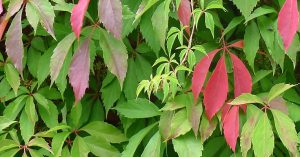
Even though it’s named for a neighboring state, the Virginia Creeper is a great vine to grow in Maryland. Gardeners may also hear it referred to as Victoria Creeper, Five-leaved Ivy, and Five-finger. It comes from a family of flowering vine, and the species is a wonderful addition to every garden.
Its leaves are made up of five leaflets while sometimes the younger vines may only have three. Some of the mature vines may possess up to seven, however, five leaflets are most common. Each share a central point on the leafstalk. Leaves range in size from one to eight inches across or more.
Virginia Creeper’s seedlings produce heart-shaped cotyledon leaves. The vine is often mistaken as False Virginia Creeper because they have similar leaves. Virginia Creeper blooms from June through July boasting green flowers. They’ll then turn into interesting round ball-like fruits. The pleasant plant is a perennial and very easy to care for.
3. Crossvine (Bignonia Capreolata)
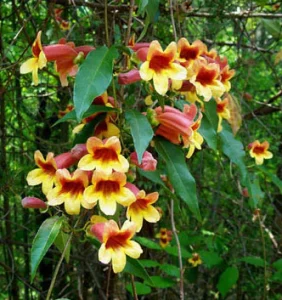
Crossvine is a colorful semi-evergreen plant that begins to bloom in March. Enjoy its vibrant red and yellow blooms straight through to May. There may also be a touch of reddish orange in the flowers, too. It’s another low maintenance vine, and it grows fast and plush.
Crossvine thrives in the direct sun, so be sure to leave a sunny place in the landscape for this popular favorite. Its unique flowers will demand attention with the help of the wonders of the full sun to hasten their bloom year after year. As a climbing vine, it can grow to a height of 50 feet. The trumpet-shaped green leaves are the perfect backdrop to this attractive flowering vine.
4. Honeysuckle (Lonicera)
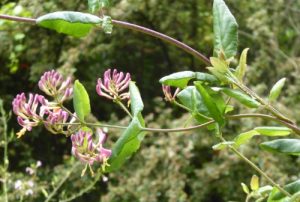
Brighten the garden with beautiful honeysuckle vine. The leaves are a rich deep green in an oval shape. Its stalks are short and barely visible which adds to the intrinsic beauty of Honeysuckle. Everywhere the eyes can see is filled with cream colored flowers when the plant is in bloom.
The trumpet-like flowers change from cream to yellow-orange, and they’re frequently enhanced with a red or pink tone. This pretty plant adds a touch of privacy when planted along the property line. The next enchanting blooms are clusters of fruits which appear as fascinating red berries. As the signs of autumn arise, the red berries will ripen.
Homeowners across Maryland enjoy the highly fragrant vine. Its colorful and fragrant characteristics make it a wonderful garden plant. Even the sweet little hummingbirds can’t resist the appeal of Honeysuckle. They’re as naturally attracted to the bright clusters of amazing flowers as are their human counterparts!
5. Prickly Pear (Opuntia Humifusa)
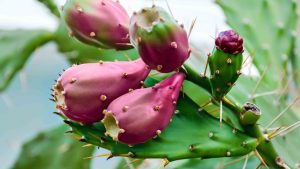
The Prickly Pear plant is also referred to as Pear Cactus. It’s a trunk-forming segmented cactus that can grow up to 16 to 23 feet high. The large plant has a wide crown plus a trunk diameter of about 36 inches. Prickly Pear contains large pads that range in color from green to a bluish green.
Prickly Pear will usually grow bearing flat, rounded cladodes. These particles have mainly smooth fixed spines along with tiny hair-thin prickles. The prickles are called glochids. The flowering Prickly Pear will bloom in the early spring through July. It’s a perennial cactus that offers large yellow and white flowers.
6. American Bittersweet (Celastrus Scandens)
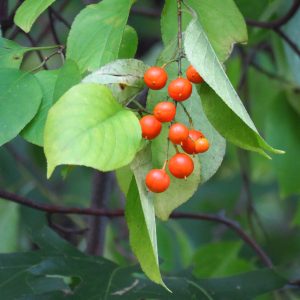
American Bittersweet is a hardy plant that looks decorative in the garden with an abundance of fruits and berries. This species of Bittersweet typically blooms in June. The plant does well when planted in rich drained soil and preferably in woodlands.
The vine is a perennial that characteristically might have twining. American Bittersweet’s stems grow to around 30 feet long and could even exceed that number. The stems measure in at about an inch thick and frequently thicker at its base. It features a yellow, green, and brown blend of colors.
American Bittersweet produces small unscented flowers that emerge from the top of its branches. This vine offers orange-colored fruits about the same diameter as a pea. Birds are fond of the fruits, but people should not ingest them. Harvest time for the berries is in the fall. American Bittersweet is easy to grow and requires little maintenance.
7. Vasevine (Clematis Viorna)
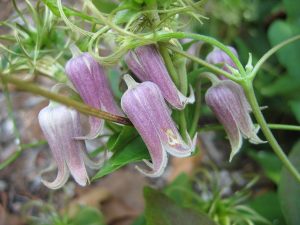
Vasevine is a vigorous vine, and it’s very easy to grow. It does well in rich, well-drained soil in a woodland place. Vasevine is a perennial plant that can live for many years in an appropriate habitat. It prefers partial to mostly shaded areas.
This beautiful plant produces star-like flowers. The flowers are a pretty creamy white in color. They are as pleasingly scented as they are dainty and appealing. In full bloom, the small flowers will fully cover the entirety of the Vasevine. It grows to 20 feet high or more. Additional names for this vine include Leatherflower and Northern Leatherflower. Small silvery beads on the plant account for its unique sheen.
8. Snapdragon (Maurandella Antirrhiniflora)
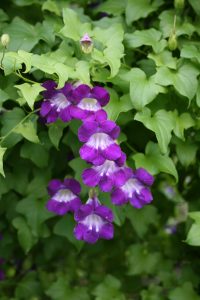
Snapdragon is also frequently called Roving Sailor and Molino Basin. The eye-catching Snapdragon is a flowering perennial plant. Its leaves are most accurately described as lance-shaped. The Snapdragon flower is tubular and mostly symmetrical. Typically large in size, the flowers feature a closed lip-like mouth that has interesting effects.
The tight-lipped flowers serve to prevent most common insects from entering. It performs the task well with the insect population, however, bees can usually squeeze their way through. Flowers in full bloom are a soft pinkish-rose color.
For the best results, plant Snapdragons after the soil has warmed up from the wintry chill. The plant thrives in an area of full sun or lightly shaded spots. The Snapdragon can handle most soil conditions including sandy areas making it a versatile choice.
9. American Wisteria (Wisteria Frutescens)
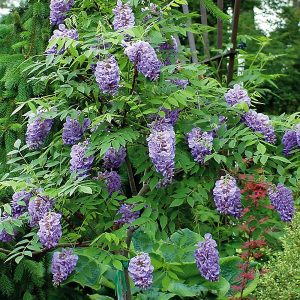
This plant is another appealing option as a woody, deciduous climbing vine. American Wisteria is a perennial, and it requires only minimal care. It dependably grows in a clockwise direction around a trees.
American Wisteria is a flowering species. It will typically bloom after the leaves are fully developed. Landscapers can expect the flowers to grow to approximately one to six inches in length.
When the vine blooms in late May or early June, a beautiful cascade of flowers come to life. The flowers are a colorful blend of lilac with a bluish hue. A lacy look of foliage delicately surrounds the blooms. The bloom period typically lasts until August. Wisteria’s leaves are shiny and dark green. Each leave has up to 15 leaflets. One leaflet grows at the tip of each stem.
10. Devil’s Darning Needles (Clematis Virginiana)
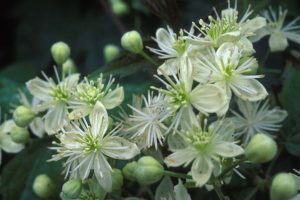
Devil’s Darning Needle is a popular climbing vine. The vine will attach with its delicate tendrils to trees or a fence. It does so in a way that won’t do harm to the supporting object.
The vine can grow 25 or more feet high. It trails around other shrubs usually in a moist area. The flowers have feathery tails. They are at their best in the late summer. The vine is able to support itself with the aid of its own strong twisted stems.
Bees and hummingbirds are naturally attracted to this plant. The flowers the vine produces are white in color. The attractive blooms are visually appealing throughout the summer months.
11. Crossvine (Bignonia Capreolata)
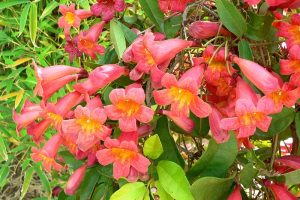
Crossvine bears the characteristics of a semi-evergreen, fast growing vine. It produces a trumpet-shaped flower which is about the size of a thumbnail. These beautiful little flowers bloom in the mid spring.
A robust vine, Crossvine can grow to a height in excess of 50 feet. It’s a perennial plant, and its flowers are a charming orange color.


